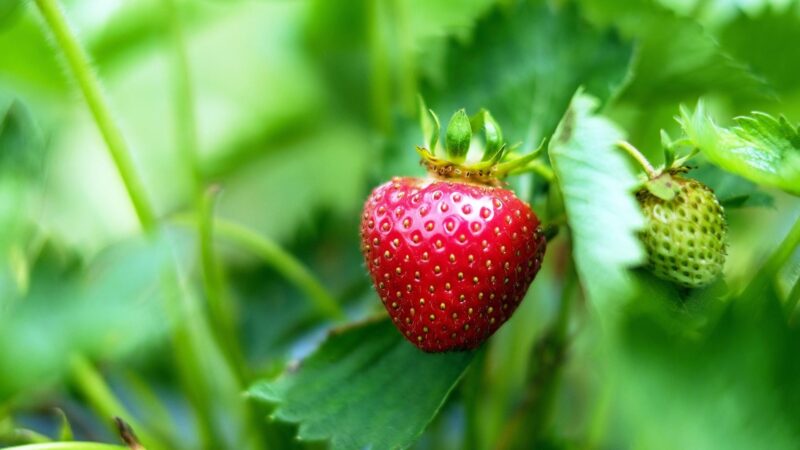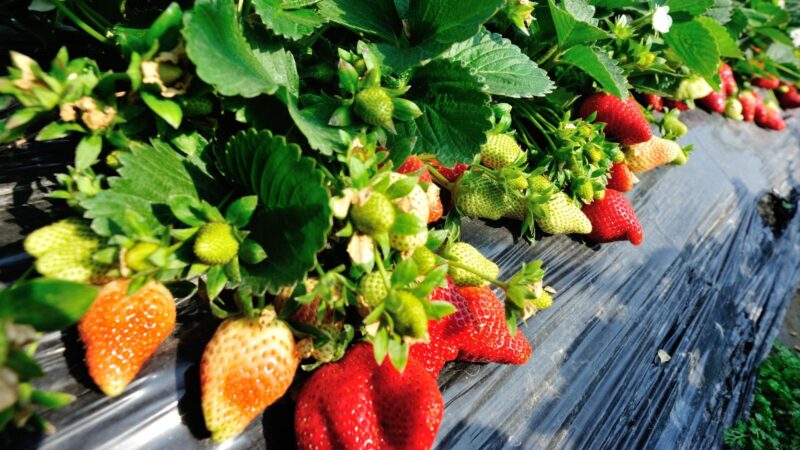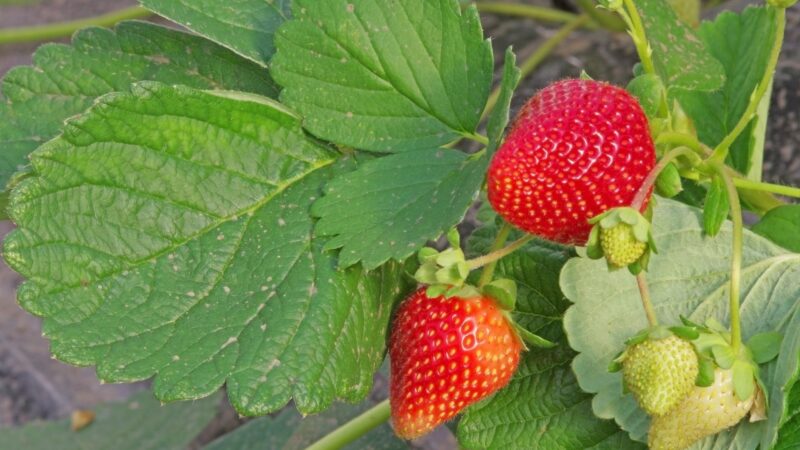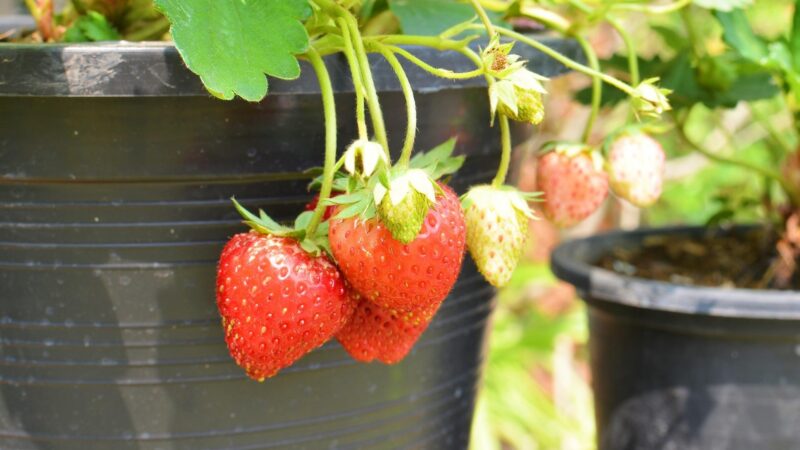Strawberries are ideal plants to grow in home gardens since they require relatively smaller amounts of space compared to other plants. One of the best ways to ensure they reach their optimal growth and fruit yield is to select and apply the best fertilizer.
So, what is the best strawberry fertilizer? It depends on your needs! Luckily, we have curated a list of optimum choices for you:
- Down To Earth Organic Starter Fertilizer Mix 3-3-3
- FoxFarm Acid Loving Plant Fertilizer 4-5-3
- Miracle-Gro Shake ‘N Feed, Fruits And Vegetables 10-10-10
- Vitax Organic Strawberry Plant Liquid Fertilizer 4-2-6
- Miracle-Gro Performance Organics Plant Nutrition 7-6-9
- Espoma Organic Berry-Tone Strawberry Plant Food, 4-3-4
- Down To Earth All Natural Acid Mix Fertilizer 4-3-6
To know more about these products, their specifications, how to use them, and related information regarding the fertilization of strawberry plants, simply read further this article!
Do I Need to Fertilize Strawberry Plants?

Established strawberry plantings should be fertilized at least once a year. Fertilizer application allows the fruits to absorb essential macronutrients that can aid them in achieving their optimal growth.
It also encourages a bountiful crop of lush berries to come to the next harvest due to increased root growth, especially when applied at the right time and in combination with soil management practices, such as increasing the amount of soil organic matter by using crop residues and cover crops.
What Is the Best Fertilizer Ratio for Strawberries?
For June-bearing strawberries, apply 0.30 ounces of nitrogen fertilizer per 10 feet of planting area. For everbearing and day-neutral strawberries, apply 0.60 ounces of nitrogen fertilizer per 10 feet of planting area.
If you have a larger area for strawberry plantings, apply 5 pounds of 10-10-10 or 13-13-13 (nitrogen-phosphate-potassium) per 100 feet of row or 3 pounds of 21-0-0 (ammonium sulfate) per 100 feet of row for any strawberry variety.
What Are the Different Organic Fertilizers for Strawberries?

Powder
Powdered fertilizers are mixed with water and are directly applied at the base of the plant or on its foliage. This variant is commonly used for perennials, such as strawberries, when transplanted, as well as annuals to promote faster root growth.
It is best applied in early spring and requires frequent applications, which makes it an ideal choice for everbearing and day-neutral strawberries.
Granules
Granular fertilizers are a type of dry fertilizers that are incorporated into pellets or granules. Depending on the product, they are usually formulated as slow-release fertilizers, which release small amounts of nutrients into the soil over a certain period of time.
They are usually mixed with the growing medium before application or mixed with other granular fertilizers in a proper ratio to create one whole fertilizer blend. Granular fertilizers are also resilient as they do not salt out during colder temperatures.
Liquid Strawberry Fertilizer
Liquid organic fertilizers (LOF) are either applied on the ground or foliage. These variants have gained popularity in the past decade since they are ideal fertilizers used to treat deficiencies and supplement nutrients to the soil during the mid-season.
According to a 2019 study, gardeners can increase the growth and yield of strawberries when using liquid organic fertilizers made of vegetable waste and planting media.
What Are the Best Strawberry Fertilizers?
Down To Earth Organic Starter Fertilizer Mix 3-3-3
- Down To Earth Starter Mix 3-3-3 in a five pound box. This all...
- Listed by the Organic Materials Review Institute (OMRI) for use...
- A mild fertilizer with 3% nitrogen, phosphorus and potassium that...
- Diverse mix of beneficial nutrients to ensure successful...
- Ingredients: Alfalfa Meal, Fish Bone Meal, Langbeinite, Oyster...
Type: Coarse meal mixture
Active Ingredients: 3% total nitrogen, 3% available phosphate, 3% soluble potash, 6% calcium, 1% magnesium, 2% sulfur, 0.5% iron
Specifications: As the name suggests, this is best used for young plants and seedlings due to its mild formulation. It also incorporates 4 species of endomycorrhizal fungi to ensure extensive root development, successful planting, and vigor in growing.
Application Rates:
- For strawberries grown on gardens and raised beds: Apply 2.5 to 5 pounds per 100 square feet of area and mix into the upper 3-inch layer of soil if the garden is new. For established plants, side dress 2 to 4 ounces of fertilizer.
- For strawberry transplants: Pour 1 to 2 tablespoons per transplant hole, mix into the soil, then water thoroughly.
- For strawberries grown in outdoor containers: Add 2 tablespoons per gallon of soil if the planting is new and 2 to 4 tablespoons per gallon if the berries are already established.
Product Dimensions: 16.5″ (length) x 11″ (width) x 11″ (height), with a weight of 5 pounds.
FoxFarm Acid Loving Plant Fertilizer 4-5-3
- NURTURES ACID-LOVING BEAUTIES: This acid fertilizer for plants is...
- CONSISTENT SLOW-RELEASE NUTRITION: Our acidic fertilizer for...
- MYCORRHIZAL MAGIC FOR ROBUST ROOTS: This soil acidifier for...
- HASSLE-FREE ORGANIC GARDENING: Fox farm fertilizers hydrangea...
- EASY APPLICATION FOR HAPPY PLANTS: Mix acid fertilizer for...
Type: Granular pellets
Active Ingredients: 4% total nitrogen, 5% phosphorous, 3% potassium
Specifications: This product is specially made for strawberries and other acid-loving plants as it is formulated with dolomitic lime for adjusting soil pH levels and mycorrhizal fungi to help reach optimal root development, which helps enhance water absorption and nutrient uptake. Additionally, this fertilizer can treat magnesium deficiency in your soil.
Application Rates:
- For strawberries grown in containers: Add 2 tablespoons per gallon of soil, then water thoroughly.
- For new strawberries planted in-ground: Follow a 2:1:0.5 fertilizer conditioner-soil-fertilizer ratio, sprinkle half a cup of additional fertilizer around the plant’s base for good measure, then water thoroughly.
- For established strawberries: Since strawberries grow at a maximum height of 1 foot, add a cup of fertilizer by top-dressing then water thoroughly.
Product Dimensions: 6.3″ (length) x 4.1″ (width) x 10.8″ (height), with a weight of 4 pounds.
Miracle-Gro Shake ‘N Feed, Fruits And Vegetables 10-5-15
- Feeds fruits and vegetables: Miracle-Gro Shake 'N Feed Tomato,...
- Strengthens plant walls: This plant food contains calcium to help...
- Natural Ingredients feed soil microbes: kelp, earthworm castings,...
- Application: Apply this slow-release fertilizer evenly onto the...
- Ongoing care: Reapply Miracle-Gro Shake 'N Feed Tomato, Fruit &...
Type: Granular pellets
Active Ingredients: 10% total nitrogen, 5% available phosphate, 15% soluble potash, 5.6% calcium, 2.9% magnesium, 6% sulfur, 0.05% copper, 0.92% iron, 0.35% manganese, 0.11% zinc
Specifications: Composed of essential micronutrients that can help form resilient plant cell walls, produce higher quality yield, and prevent plant diseases, blossom end rot, and fruit cracking. It is also conveniently easy to use, just simply open the spout, shake around the strawberry plants’ soil, and you would be good to go! Avoid applying it onto wet foliage or letting it pile against the plant stem.
Application Rates:
- For strawberries grown in-ground: shake 1 tablespoon of fertilizer onto the soil, work into the upper 1 to 3 inches of the soil by lightly raking, then water thoroughly.
- For strawberries grown in containers: similar to the instructions above. Refer to the table below for the right application rates:
| Container Diameter | 8” | 10” | 12” | 14” |
| Amount of Fertilizer | 2 ¾ tbsp | 2 tbsp | 3 ¾ tbsp | 7 tbsp |
Product Dimensions: 4.13″ (length) x 9.8″ (width) x 7.5″ (height), with a weight of 4.5 pounds.
Vitax Organic Strawberry Plant Liquid Fertilizer 4-2-6
Type: Liquid fertilizer
Active Ingredients: 4% total nitrogen, 2% phosphorus pentoxide, 6% potassium oxide
Specifications: This fertilizer is manufactured with essential trace elements and naturally occurring nutrients to provide your strawberry plants with a constant supply of nutrients, promote healthy and strong growth, and increase fruit yields.
Application Rates:
Before application, dilute 1 capful of fertilizer into 5 liters of water.
- For strawberries grown in tubs and bags: Apply 1 liter of the diluted mixture per bag on the first week of treatment, then gradually increase up to 4.5 liters per week.
- For strawberries grown outdoors: Apply 2 liters of the diluted mixture onto each plant every 14 days, then once every 7 days after the first application.
- For strawberries grown under cover: Apply 2 liters of the diluted mixture to each plant every 7 days after they have set.
Product Dimensions: 8.4″ (length) x 4.5″ (width) x 2.4″ (height), with a weight of 2.76 pounds.
Miracle-Gro Performance Organics Plant Nutrition 7-6-9
- Use Miracle-Gro Performance Organics Edibles Plant Nutrition...
- OMRI listed plant food provides vital nutrients for bigger...
- Enjoy Miracle-Gro results with organic and natural ingredients
- Reapply every 4-6 weeks and water regularly for best results
- Covers up to 220 sq. ft.
Type: Water-soluble granules
Active Ingredients: 9% total nitrogen, 4% available phosphate, 12% soluble potash, 4.5% calcium, 0.05% copper, 0.10% iron, 0.05% manganese, 0.05% zinc
Specifications: A great starting fertilizer for new plants to help them acquire necessary nutrients and achieve their highest potential growth. With that, you can expect to have bountiful fruit yields once you start harvesting! This product can also treat calcium and magnesium deficiencies in your soil.
Application Rates:
When measuring, use the enclosed scoop that is equal to 1 tablespoon.
- For strawberries grown in small planting areas: Mix 2 level scoops to a gallon of water for outdoor strawberries and 1 level scoop to a gallon for indoor strawberries; both mixtures can cover 10 square feet. Feed the strawberries by soaking the mixture at the base of the plant, then repeat once every 7 days.
- For strawberries grown in large planting areas: Fill a garden feeder with 3/4 pounds of the fertilizer. This can cover approximately 200 square feet. Add any attachments to your garden feeder, such as a sprayer head, to properly distribute the mixture. Feed the strawberries once every 7 days.
Product Dimensions: 4.13″ (length) x 7.5″ (width) x 9.8″ (height), with a weight of 2.5 pounds.
Espoma Organic Berry-Tone Strawberry Plant Food, 4-3-4
- FOR USE ON: Use Berry-tone organic fertilizer for all berries...
- CONTAINS: Berry-tone is a rich blend of the finest natural &...
- WHEN / HOW TO USE: Best to use Berry-tone fertilizer when...
- FOR ORGANIC GARDENING: Berry-tone is approved for organic...
- MADE IN THE USA: Product of the Espoma Company. The leader in...
Type: Slow-release powder
Active Ingredients: 4% total nitrogen, 3% available phosphate, 4% soluble potash, 5% calcium, 1% magnesium, 5% sulfur
Specifications: This long-lasting, slow-release fertilizer can help you achieve bigger-sized, more flavorful fruit and healthier growth. It also has beneficial microbes that help your strawberries establish faster, develop roots with just the right depth, and have high-quality blooms. An added bonus is that this product won’t cause fertilizer burn!
Application Rates:
- For new strawberry plantings: Make sure the hole for each planting is deep enough for the roots to grow into or else they’ll be damaged when applied with fertilizer. Remove half of the soil and replace it with peat moss or compost, then add a cup of fertilizer to it. Place the strawberry plant in the hole, pack it with more soil, soak it with water, and allow it to settle.
- For established strawberries: Sprinkle 1 cup of the fertilizer around the diameter of the drip line of the strawberry plant. If you have added mulch prior, remove it first before feeding or feed twice as much as the rate.
- For strawberries grown in garden beds: Mix 10 pounds of the fertilizer onto the upper 4 inches of the soil per 100 square feet for new beds. For established beds, mix 5 pounds.
- For strawberries grown in containers: Add 2 cups of fertilizer per cubic foot of soil for new plants and 1 teaspoon per 3 inches of pot diameter, then water thoroughly afterward for established plants.
Product Dimensions: 12″ (length) x 4″ (width) x 6″ (height), with a weight of 4 pounds.
Down To Earth All Natural Acid Mix Fertilizer 4-3-6
- A Natural fertilizer blended especially for acid lovers such as...
- To encourage lush flowers and fruit, apply Acid Mix in early...
- Fall Applications can help promote root growth and boost...
- All-Natural Ingredients: Made from organic, sustainably sourced...
- Slow-Release Formula: The slow-release nature ensures a steady...
Type: Dry fertilizer
Active Ingredients: 4% total nitrogen, 3% available phosphate, 6% soluble potash, 3% calcium, 2% magnesium, 2% sulfur
Specifications: Made especially for acid-loving plants, such as strawberries, this product can encourage the growth of lush fruit and flowers, root efficiency, and increase your strawberries’ resistance to extremely cold temperatures. Just remember to apply during early spring and fall for the best results!
Application Rates:
- For new strawberry plantings: Mix half a cup of fertilizer into the soil, use amended soil to fill it back in, and water thoroughly.
- For established plantings: Add 1 cup per plant by simply mixing it into the soil surface, then water thoroughly.
- For strawberries grown in containers: Add 1 to 2 tablespoons of fertilizer per gallon of soil.
Product Dimensions: 3.8″ (length) x 8.1″ (width) x 10.7″ (height), with a weight of 5 pounds.
How to Use Strawberry Fertilizers? | A Step by Step Guide
Step 1: Perform a soil test to determine how much lime and fertilizer your soil needs. Have your soil tested for nematodes as well. If the test results recommend that lime and other nutrients, such as potassium or phosphorus, should be added or treatment for nematodes is required, do as suggested.
Step 2: Make sure you periodically till or spade your planting area so that any weeds present will not produce seeds and cause future problems for your strawberries.
Step 3: A week before planting, broadcast the fertilizer over the planting area by applying it on the surface across the entire field. Specifically, apply the fertilizer onto dry foliage, then sweep the plants using a leaf rake or broom after application. When using organic fertilizers, follow the label provided by the manufacturer for the proper application.
Step 4: Afterward, till the soil and smoothen the garden bed. If there is rainfall, allow the soil to be settled since it shouldn’t be too wet. However, if there was no rainfall or it was insufficient, pour 1 to 1.5 inches of water a week. Add mulch following fertilization to avoid getting the berries soiled.
Step 5: Repeat the process per application.
Step 6: Apply fungicides if rains in your area are frequent during the harvesting period.
When to Fertilize Strawberries?

Generally, fertilizer should be applied 2 to 3 weeks before planting or 6 weeks after planting to prevent the risk of fertilizer burn. However, the timing of fertilization depends on the type of strawberries you have. Here is a guide on the best time to fertilize strawberries:
- June-bearing strawberries: These fruits should be fertilized in August, immediately after the season’s last harvest. Avoid fertilizing in spring as it results in softer berries, overly vigorous foliar growth, and increases the fruit’s vulnerability to diseases.
- Everbearing and day-neutral strawberries: Fertilize in early spring and another time in early August, or fertilize once a month from June to September.
How Can I Make My Strawberries Grow Bigger and Sweeter?

- Plant Site Selection. The planting area should be able to receive full sunlight and have raised or gradual-sloped beds. Do not plant near peppers, tomatoes, eggplants, or peppers as well as in recently plowed grass or areas with sod. The berries should also be near a water supply.
- Soil Preparation. Strawberries grow best in well-drained, sandy soil that is rich in organic matter and has a pH level of around 5.3 to 6.5. Soil testing is also important so that you’re aware of any nutrient deficiencies your soil requires.
- Planting System. The most ideal planting system for strawberries is the matted row where you plant them 18 inches apart in rows that are 48 to 52 inches apart.
- Weed Management. Regularly cultivate the soil by hand-pulling or hoeing weeds as they can strongly compete with strawberries for water and nutrients, as well as promote plant bug populations and diseases.
- Mulching. Although strawberries can withstand cold temperatures, applying mulch increases their tolerance. It also helps them avoid root damage and other injuries.
- Renovation. After harvest, renovate strawberry beds by cultivating the soil, cutting foliar canopy, and applying herbicides to get ready for the next batch of strawberries.
Are Eggshells Good for Strawberries?
Eggshells are good for strawberries. Generally, spreading eggshells around plants is a good practice as they are considered soil amendments due to their high calcium content. Eggshells should be grinded and used on soil that is lacking in calcium or as supplements to compost.
Are Coffee Grounds Good for Strawberry Plants?
Coffee grounds are good for strawberry plants, as they are beneficial to your soil since coffee grounds contain compounds that suppress disease-causing microbes and feed soil organisms. They are also excellent supplements for compost. However, contrary to popular myth, coffee grounds are unable to lower soil pH levels.
Is Epsom Salt Good for Strawberries?
Epson salt is good for strawberries, but only if your soil has a magnesium deficiency. Otherwise, it is unnecessary to add Epsom salts to the soil as it can potentially harm the plant and its calcium uptake abilities, which can consequently cause blossom end rot.
Strawberries need fertilizers, either in powder, granular, or liquid form, to be able to absorb important nutrients and achieve their optimal growth and fruit yield. June-bearing strawberries should be treated once in August, while everbearing and day-neutral strawberries can be fertilized either once in early spring and another in early August or once every month from June to September.
List of Sources
Growing Strawberries in the Home Garden
Organic Fertilizers – Thoughts on Using Liquid Organic Fertilizers for Greenhouse Plants






